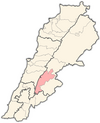Kefraya
Kefraya
كفريا | |
|---|---|
Town | |
| Coordinates: 33°40′15″N 35°44′11″E / 33.67083°N 35.73639°E | |
| Country | |
| Governorate | Beqaa Governorate |
| District | Western Beqaa District |
| Founded by | Hala Saleh |
| Government | |
| • Time Zone | GMT +2 (UTC) |
| • - Summer (DST) | +3 (UTC) |
| • Area Code(s) | (+961) 1 |
| Time zone | UTC+2 (EET) |
| • Summer (DST) | UTC+3 (EEST) |
| Dialing code | +961 |
Kefraya (Arabic: كفريا / ALA-LC: Kifrayā) is a village in the Western Beqaa District of the Beqaa Governorate in the Republic of Lebanon, approximately 7 kilometres (4.3 mi) northwest of Joub Jannine.[1] The village is home to a mixed population of Sunnis and Greek Catholics.[2]
Château Kefraya
It is known for its vineyards and Château Kefraya wines. Château Kefraya is the second biggest winery in the Beqaa Valley with land that extends up to 3,000 acres (12 km2) amongst the foothills of Mount Barouk, 20 kilometres (12 mi) south of the town of Chtaura. It was established in 1951 by its owner Michel de Bustros (Bustros Family). Shares of the winery are owned by Walid Jumblatt.[3] Chateau Kefraya exports wines to a number of countries in America, Europe, Middle East, Asia, Oceania, and Africa.[4]
Archaeology
Kefraya was also once home to the Qaraoun culture with a Heavy Neolithic archaeological industry prior to the Neolithic Revolution.[5][6] A very large archaeological site was discovered in the area running along both sides of the road. Good quality flint nodules were found amongst Eocene conglomerates where a Heavy Neolithic factory site was detected with a massive abundance of Levallois cores, debitage and waste littering the surface of the site. Large numbers of flint tools were collected by workers that included a variety of scrapers on flakes, knives, axes, adzes and a segmented sickle blade.[7] The type of flint found in the area was termed Kefraya flint.[8][9]
References
- ^ Université Saint-Joseph (Beirut, Lebanon) (1966). Mélanges de l'Université Saint-Joseph. Impr. catholique. Retrieved 26 August 2011.
- ^ "The Monthly - issue 91" (PDF). localiban. p. 7. Archived from the original (PDF) on 4 March 2016. Retrieved 25 December 2015.
- ^ Robert Joseph (1 December 2006). Wine Travel Guide to the World. Footprint Travel Guides. pp. 346–. ISBN 978-1-904777-85-4. Retrieved 26 August 2011.
- ^ "Chateau Kefraya - Distributors Across the World".
- ^ Fred Wendorf; Anthony E. Marks (1975). Problems in prehistory: North Africa and the Levant. SMU Press. ISBN 978-0-87074-146-3. Retrieved 26 August 2011.
- ^ Raymond Vaufrey (1968). La Préhistoire: problèmes et tendances. Éditions du Centre national de la recherche scientifique. Retrieved 26 August 2011.
- ^ Moore, A.M.T. (1978). The Neolithic of the Levant. Oxford University, Unpublished Ph.D. Thesis. pp. 446–447.
- ^ Dorothy Anne Elizabeth Garrod; L. Copeland (1983). Adlun in the Stone Age: the excavations of D.A.E. Garrod in the Lebanon, 1958-1963. B.A.R. ISBN 978-0-86054-203-2. Retrieved 26 August 2011.
- ^ Francis Hours (1994). Atlas des sites du proche orient (14000-5700 BP). Maison de l'Orient méditerranéen. ISBN 978-2-903264-53-6. Retrieved 26 August 2011.


